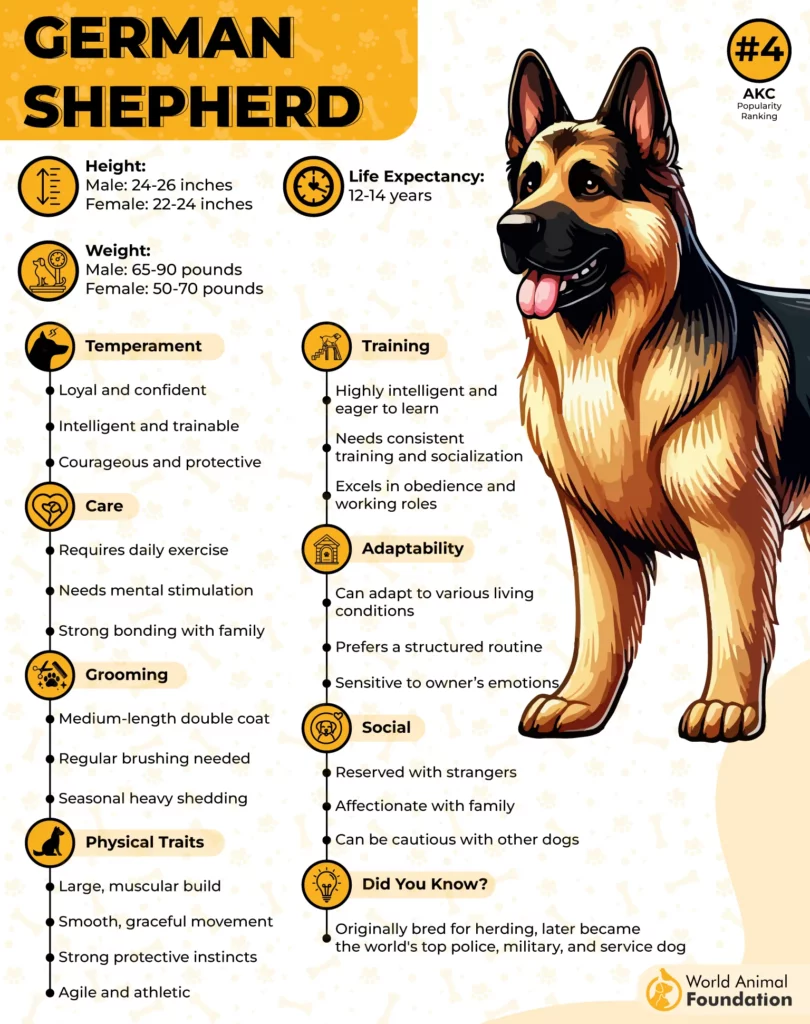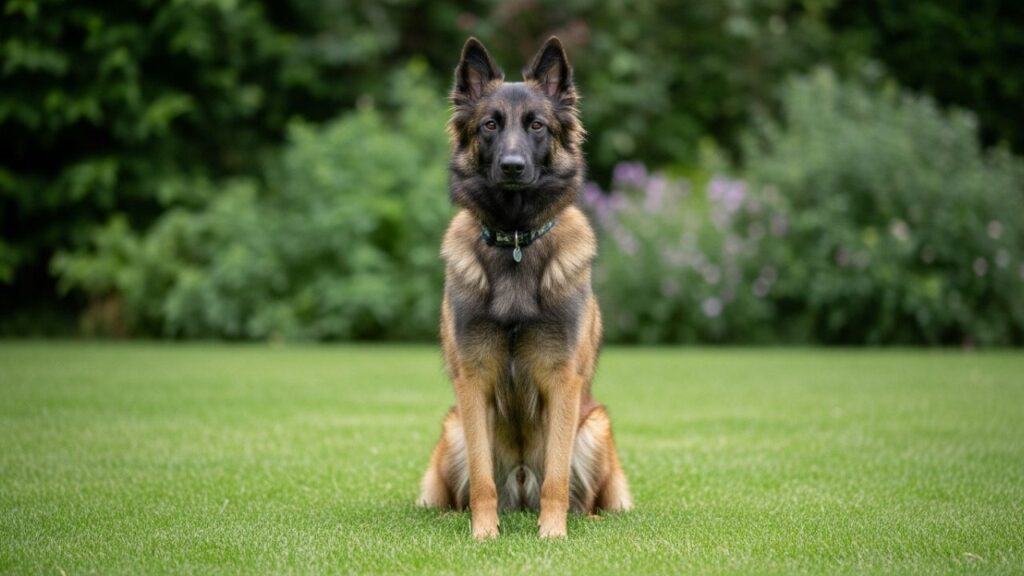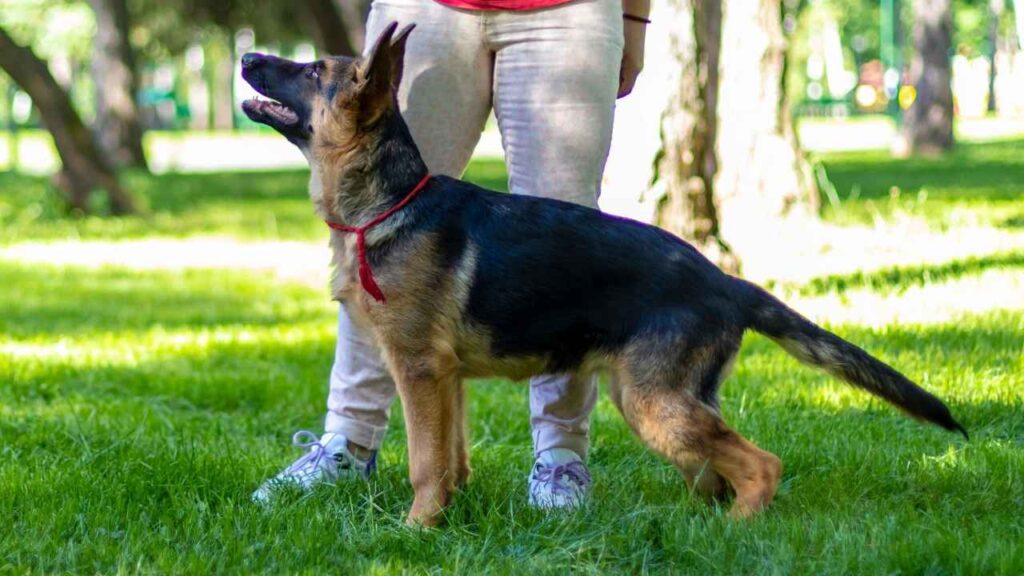Both German Shepherds and Belgian Shepherds are herding dogs having similar personality traits and physical characteristics. Dog lovers value both breeds due to their versatility and strong work ethic. Both are well-suited for military and police work and search and rescue missions.
However, there are some key differences that set the two breeds apart. While German Shepherds have no recognized varieties, Belgian Shepherds have four distinct variants, including Belgian Malinois, Belgian Laekenois, Belgian Tervuren, and Belgian Sheepdog.
This article sheds light on the similarities and differences in their appearance, temperament, intelligence, and trainability. If you are planning to adopt one of the two breeds, this article can be of great help.
Have a look at these differences between German Shepherd dogs and Belgian Shepherds.
German Shepherd vs. Belgian Shepherd
Origins & Purpose
As the name indicates, German Shepherds were originally bred in Germany, while Belgian Shepherds originate from Belgium. Belgian Shepherds were refined in the 1800s from herding dogs. Both Belgian Malinois and German Shepherds were bred for identical purposes, i.e., herding.

A German cavalry officer, Captain Max von Stephanitz, combined different herding breeds to create a uniform breed known as the German Shepherd today. The breed’s popularity decreased during World War I as it was associated with the enemy.
Later, they began to be called Alsatians. This name is still commonly used in the United Kingdom. Their athleticism, bravery, and courage make these versatile dogs ideal for police work, military work, and search-and-rescue operations.
Size & Physical Appearance
The foremost difference between the two breeds lies in their size. German Shepherd dogs are larger than Belgian Malinois. While the Belgian Shepherds reach up to 26 inches tall whereas German Shepherd dogs grow up to 27 inches tall.
Belgian Malinois, or more precisely Belgian Shepherd, looks like a smaller version of the German Shepherd. German Shepherd dogs have a distinct brown coat with a black pattern. Belgian Malinois are short-haired dogs with a fawn-colored coat, a black overlay, a black mask, and ears.

Belgian Malinois dogs are a bit more sleek, but still muscular and nearly tireless. Mals have erect ears, triangular in shape, while GSDs have larger and upright ears. Belgian Tervuren has a similar coat color, but it has comparatively long fur.
Belgian Sheepdog or Groenendael has a long, natural, rustic black coat that looks absolutely stunning. Lastly, Belgian Laekenois have a fawn or reddish coat with a trace of black on the muzzle and tail.
Coat Maintenance
All varieties of Belgian Shepherds, including Belgian Malinois, Belgian Tervuren, Belgian Laekenois, and Belgian Sheepdog, as well as German Shepherds, have thick double coats. Their coats are weather-resistant and protect them against cold climates.
As a result, these strong canines can work efficiently even in colder temperatures. Coat maintenance is easy for both breeds. You only need to give your pooch a quick brushing every few days to remove mats and tangles.

Both breeds shed throughout the year, especially during the two “coat blow” periods. However, German Shepherds may shed relatively more.
Energy Levels & Exercise Needs
Both German Shepherds and Belgian Shepherds have high energy levels and need plenty of exercise for physical and mental stimulation. At least one and a half to two hours of activity is required every day to keep both breeds happy.
According to PetMD, German Shepherds are highly energetic dogs who love having a job or an outlet for regular exercise. All Belgian Shepherds, including the most popular Belgian Malinois dogs, are also very active.

Their high energy levels mean they also need plenty of exercise for physical stimulation. However, Belgian Shepherds are more agile dogs and tend to have higher energy than GSDs. It may be attributed to their sleek build compared to German Shepherds.
Temperament & Family Compatibility
Since both breeds are bred to work, they have quite similar temperaments, but there are some key differences between them.
Both German Shepherd dogs and Belgian Shepherds are smart and eager to please canines. They are immensely loyal to their people and form strong bonds with owners. Both love having a job to do and have strong protective instincts, so they stand guard against all potential threats.

Neither breed can stand when left alone in the yard for several hours. GSDs and Belgian Malinois tend to be wary of strangers and are territorial. However, Belgian Malinois is more friendly and welcoming compared to the German Shepherds.
The same holds for other breed varieties as well. Both make excellent guard dogs, but German Shepherds tend to be more suspicious of strangers.
Training, Intelligence, & Workability
German Shepherd dogs and Belgian Shepherds both tend to be highly intelligent. Thanks to their eager-to-please nature and ability to learn quickly, GSDs and Belgian Shepherds respond well to training. In fact, the AKC describes GSDs as one of the easiest breeds to housetrain.
They excel at various tasks, including military and police work. Once these canines have completed basic training, you can train them for plenty of dog sports like agility, herding, obedience, and schutzhund through advanced training methods.

With proper training and early socialization, both Belgian Shepherds and German Shepherd dogs make wonderful family pets. Being working dogs, both breeds have a high work drive and are quite versatile. They are quite alert to their surroundings and are hardwired to protect their loved ones.
Health & Lifespan
Both Belgian Malinois and German Shepherds are large dogs, having a high risk of developing hip and elbow dysplasia. German Shepherds are more prone to a condition called degenerative myelopathy, which affects the dog’s spinal cord and can even lead to paralysis.
According to PetPlan, German Shepherds can develop certain types of cancers, such as Haemangiosarcoma, a tumor that develops in the lining of the blood vessels of the spleen, liver, and kidney. Both Belgian Shepherds and GSDs are deep-chested dogs.

Deep-chested canines are more prone to a life-threatening health issue called “bloat” or Gastric Volvulus Dilatation. It is important to be mindful of the eating habits of your pooch, regardless of the breed you adopt. Also, ensure regular vet check-ups to minimize the risk of such problems.
German Shepherd vs. Belgian Shepherd: Best Fit for Lifestyle
German Shepherds and Belgian Shepherds are better suited for owners with an active lifestyle, thanks to their high energy levels and need for vigorous exercise. Due to their strength and size, they do better with experienced owners.

When it comes to loyalty, both breeds are incredibly loving and family-oriented, but GSDs are more child-friendly, so if you have kids at home, a German Shepherd may be a better choice. However, if your preference is a breed with endless energy and devotion, you can go for a Belgian Shepherd.
Conclusion
Both German Shepherd dogs and Belgian Shepherds are immensely loyal and loving canines, having lots of similarities. But there are some key differences between the two breeds. Belgian Shepherds have four variants, including Malinois, Tervuren, Laekenois, and Sheepdog, whereas GSDs have no varieties.
Belgian Shepherds are more sleek and agile than German Shepherds. Both breeds make wonderful guard dogs and have a protective and territorial nature, but Belgian Shepherds are a little friendlier.
Both breeds have strong working ethics and high devotion, but GSDs are more kid-friendly when it comes to family life. The ultimate choice between German Shepherds vs. Belgian Shepherds lies in your own personal preference.


